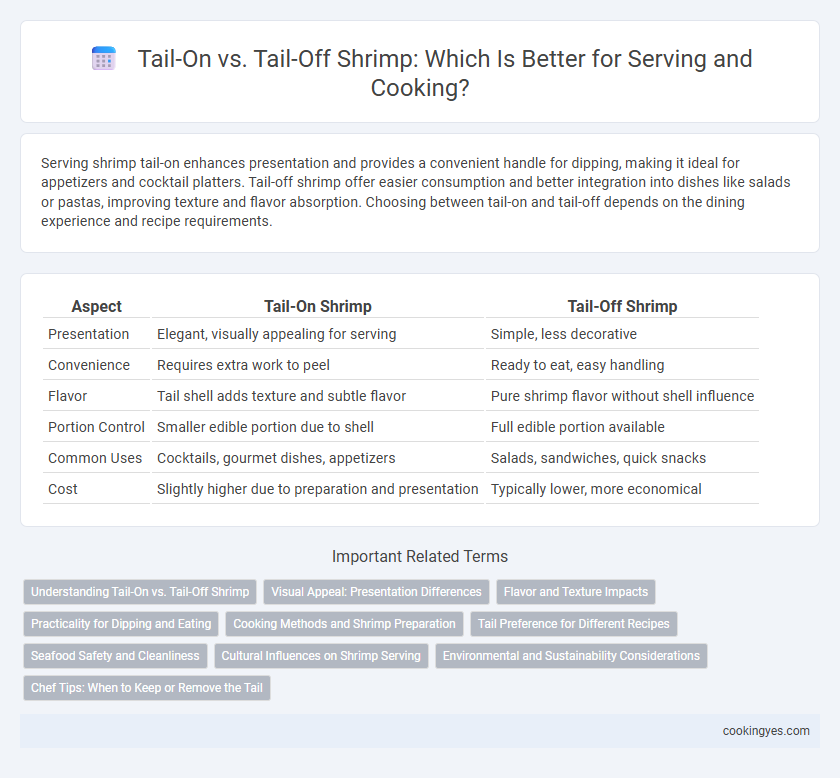Serving shrimp tail-on enhances presentation and provides a convenient handle for dipping, making it ideal for appetizers and cocktail platters. Tail-off shrimp offer easier consumption and better integration into dishes like salads or pastas, improving texture and flavor absorption. Choosing between tail-on and tail-off depends on the dining experience and recipe requirements.
Table of Comparison
| Aspect | Tail-On Shrimp | Tail-Off Shrimp |
|---|---|---|
| Presentation | Elegant, visually appealing for serving | Simple, less decorative |
| Convenience | Requires extra work to peel | Ready to eat, easy handling |
| Flavor | Tail shell adds texture and subtle flavor | Pure shrimp flavor without shell influence |
| Portion Control | Smaller edible portion due to shell | Full edible portion available |
| Common Uses | Cocktails, gourmet dishes, appetizers | Salads, sandwiches, quick snacks |
| Cost | Slightly higher due to preparation and presentation | Typically lower, more economical |
Understanding Tail-On vs. Tail-Off Shrimp
Tail-on shrimp offers a visually appealing presentation and retains more flavor due to the shell's protection during cooking, making it ideal for grilling and cocktail dishes. Tail-off shrimp provides convenience and ease of eating in recipes like shrimp salads, stir-fries, and pasta, where seamless texture integration is desired. Choosing between tail-on and tail-off shrimp depends on the dish's presentation requirements and the desired balance between convenience and flavor intensity.
Visual Appeal: Presentation Differences
Tail-on shrimp enhances visual appeal by showcasing vibrant colors and a distinct tail shape, making dishes look more appetizing and elegant. Tail-off shrimp offers a cleaner, more uniform presentation that suits casual or mixed recipes, emphasizing ease of consumption without compromising texture. Chefs often select tail-on for upscale plating and tail-off for practical, bite-sized servings.
Flavor and Texture Impacts
Tail-on shrimp retains natural juices and succulence, enhancing flavor intensity and providing a satisfying bite with a firm, slightly chewy texture. Tail-off shrimp offers easier eating and better integration into dishes, allowing marinades and seasonings to penetrate more evenly, resulting in a tender, less fibrous mouthfeel. Choosing tail-on or tail-off impacts the balance between presentation and eating experience, crucial for dishes emphasizing either robust texture or smooth, consistent flavor absorption.
Practicality for Dipping and Eating
Tail-on shrimp provide a convenient grip that enhances practicality when dipping into sauces, preventing fingers from getting messy. Tail-off shrimp offer ease of eating without the need to peel, ideal for quick consumption and recipes requiring minimal handling. Choosing tail-on or tail-off shrimp depends on balancing dipping convenience with straightforward eating preferences.
Cooking Methods and Shrimp Preparation
Tail-on shrimp retain their shell and tail, providing extra flavor and moisture during grilling, roasting, and frying by protecting the shrimp from direct heat. Tail-off shrimp ease the peeling process, making them ideal for sauteing, boiling, or incorporating into dishes like shrimp scampi or salads where convenience and quick cooking are desired. Choosing between tail-on or tail-off shrimp depends on the cooking method and desired presentation, with tail-on enhancing flavor retention and tail-off offering ease of preparation.
Tail Preference for Different Recipes
Tail-on shrimp is preferred in recipes where presentation and texture enhance the dining experience, such as shrimp cocktail, grilled shrimp skewers, or sauteed dishes, offering a firm grip and added flavor. Tail-off shrimp is favored for recipes requiring easy eating or incorporation into sauces and salads, like shrimp scampi or shrimp salad, where shell removal simplifies consumption. Choosing tail-on or tail-off shrimp depends on the desired balance between aesthetic appeal and convenience in the specific culinary application.
Seafood Safety and Cleanliness
Serving shrimp with the tail on provides a natural handle that helps prevent direct contact with the meat, reducing contamination risks and ensuring better seafood safety. Tail-off shrimp require careful handling and thorough washing to maintain cleanliness and avoid bacterial transfer. Proper storage and preparation practices remain critical regardless of tail presence to ensure shrimp safety and freshness.
Cultural Influences on Shrimp Serving
Tail-on shrimp is often preferred in Asian cuisine, where presentation and texture play a critical role in dishes like shrimp tempura and sushi. Western cultures frequently opt for tail-off shrimp to facilitate ease of eating in recipes such as shrimp cocktails and salads. These cultural preferences influence not only the dining experience but also shrimp processing and culinary usage worldwide.
Environmental and Sustainability Considerations
Tail-on shrimp retain their shells, reducing waste and allowing for more efficient recycling or composting of organic materials, which supports sustainable seafood practices. Tail-off shrimp processing generates more shell waste that often ends up in landfills, increasing environmental impact and resource strain. Choosing tail-on options helps promote circular economy principles in the seafood industry by minimizing discarded biomass and enhancing ecosystem preservation.
Chef Tips: When to Keep or Remove the Tail
Chefs recommend keeping shrimp tails on for dishes where presentation matters, as the tail adds visual appeal and a convenient handle for eating. Removing tails is ideal for recipes requiring easy access to the meat, such as stir-fries, salads, or shrimp scampi, improving texture and bite. Tail-on shrimp also retain moisture better during cooking, enhancing flavor and juiciness in grilled or baked dishes.
Tail-on vs tail-off for shrimp serving Infographic

 cookingyes.com
cookingyes.com